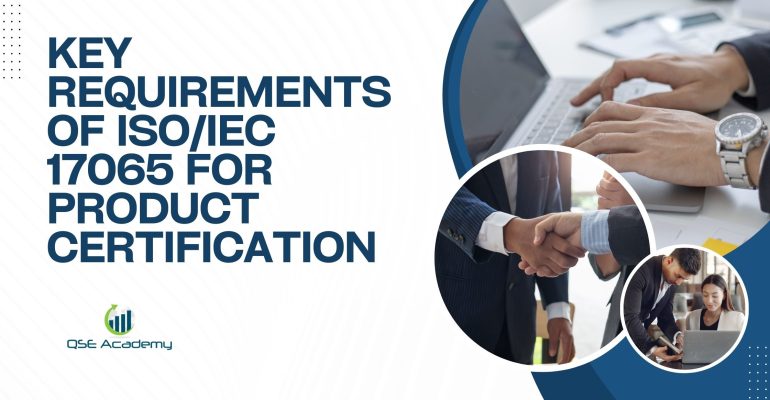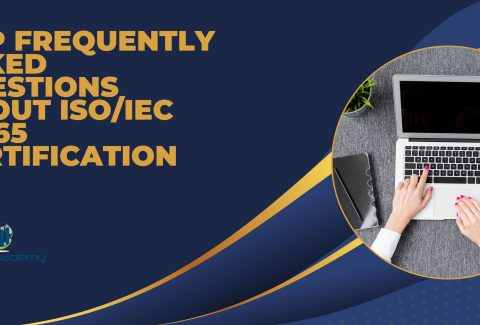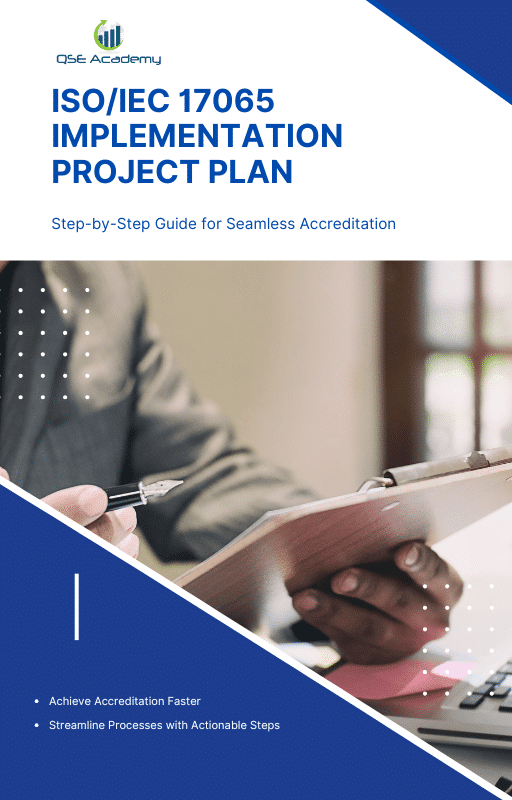Schlüsselanforderungen der ISO/IEC 17065 für die Produktzertifizierung
Imagine a world where every product you purchase meets certain global standards for quality and safety. ISO/IEC 17065 is the backbone of that trust, setting the stage for reliable product certifications. It plays a pivotal role in ensuring that certification bodies operate in a competent, consistent, and impartial manner. In this article, we will explore the key requirements laid out by ISO/IEC 17065 for product certification, providing an in-depth understanding of what it takes to achieve and maintain this important standard. From the general criteria to the nitty-gritty of management systems, join us as we dissect the standards that uphold consumer confidence and compliance in the global marketplace.
Einführung
ISO/IEC 17065, titled “Requirements for bodies certifying products, processes, and services,” is a pivotal international standard designed for product certification bodies. It establishes the criteria such organizations must adhere to ensure they operate in a consistent, impartial, and reliable manner. Being a specialized standard, ISO/IEC 17065 is integral to guiding product certification processes, ensuring they meet the rigor and integrity required for international recognition.
The significance of ISO/IEC 17065 lies in its comprehensive framework which enhances trust among consumers, regulatory authorities, and stakeholders by confirming that certified products fulfill the necessary scheme requirements. Its presence as a benchmark for product certification schemes facilitates global trade by harmonizing the certification processes.
Since its inception, ISO/IEC 17065 has evolved, capturing best practices to address the changing needs of various industries and technology advances. The standard has roots in earlier documents such as ISO/IEC Guide 65, which it replaced, reflecting an ongoing journey towards refining product certification quality and assurance.
Note: A table or list was not included in this section as the word count limit and content type for this specific task did not lend themselves to these formats effectively.
Allgemeine Anforderungen
ISO/IEC 17065:2012 outlines the requirements for bodies certifying products, processes, and services. Under the Allgemeine Anforderungen section, a certification body must ensure:
Legal and Contractual Matters:
- Legal Status: Certification bodies must be established as a legal entity to be held accountable for their activities.
- Liability and Financing: They should have policies and provisions for liability and financial stability to cover the operations and contractual obligations.
- Contracts and Confidentiality: Agreements with clients must protect confidentiality and include clear terms and conditions.
Management of Impartiality:
- Certification bodies must prioritize impartiality and manage any conflicts of interest to maintain trust in their certification services.
- Clearly defined procedures must be in place to identify risks to impartiality and establish measures to eliminate or minimize such risks.
Responsibility for Certification Decisions:
- The certification body must have formally appointed individuals who are responsible for making certification decisions, ensuring they are made objectively and independently from other processes like audits or evaluations.
Adhering to these conditions is crucial for maintaining the credibility and recognition of the certification body by international standards, regulatory authorities, and stakeholders.
Strukturelle Anforderungen
ISO/IEC 17065 establishes criteria that ensure product certification bodies are competent and impartial. A crucial aspect of this is the structural element, which mandates a clear organizational structure.
Organizational Structure of the Certification Body:
| Element | Beschreibung |
| Configuration | Defines roles, responsibilities, and reporting lines |
| Zielsetzung | To ensure impartiality and prevent conflicts of interest |
Roles and Responsibilities of Key Personnel:
- Top Management: Accountable for the overall performance and compliance with ISO/IEC 17065.
- Certification Managers: Oversee certification activities and ensure adherence to protocols.
- Technical Experts: Assess specific technical aspects within the scope of certification.
Management of Subsidiaries and Contractors:
Certification bodies must ensure that any subsidiaries or contractors operate in accordance with ISO/IEC 17065 requirements. Regular internal audits and management reviews are critical to uphold this.
Commitment to Quality
A robust quality policy, underpinned by the unwavering commitment of top management, is pivotal. This policy must emphasize a culture that actively seeks continuous improvement. Such a quality protocol is underlined by consistent management reviews, corrective actions when necessary, and a drive towards meeting and exceeding scheme requirements as well as the expectations of regulatory authorities. ISO/IEC 17065 understands the vitality of continuous commitment from leadership for sustaining the integrity of certification processes.
This section on structural requirements showcases the meticulous framework put in place by ISO/IEC 17065 to ensure reliable, competent certification practices by product certification bodies.
Anforderungen an die Ressourcen
Kompetenz des Personals
ISO/IEC 17065 outlines detailed criteria for the competence of personnel involved in the certification process. Certification bodies must ensure that their staff possess the necessary skills, knowledge, and experience related to the specific certification schemes. To achieve this, certification bodies are required to:
- Define clear competence criteria for certification personnel.
- Implement robust training and development programs.
- Regularly monitor and evaluate personnel competence to maintain high certification standards.
Such measures guarantee that the certification of products is conducted by qualified individuals, maintaining the integrity of the certification process.
Infrastruktur und Einrichtungen
Under ISO/IEC 17065, product certification bodies must pay meticulous attention to their infrastructure and facilities. This includes:
- Ensuring the adequacy of facilities and equipment for their intended purposes.
- Maintaining and calibrating equipment correctly and regularly to ensure precise operation.
- Implementing stringent security and confidentiality measures to protect sensitive information.
With proper infrastructure, certification activities can be performed consistently, and clients’ confidential information remains secure, thus upholding the credibility of the certification process.
| Maintenance and Calibration | Security and Confidential Measures |
| Regular calibration schedules | Secure data storage systems |
| Authorized personnel for maintenance tasks | Strict access controls |
| Documented procedures for equipment care | Confidentiality agreements with staff |
Prozess-Anforderungen
To meet the ISO/IEC 17065 standards, certification bodies must adhere to a structured process that guarantees fair, consistent, and reliable product certification activities. Here’s an overview of the requirements for the certification process:
- Overview of the Certification Process: The procedure must be thoroughly planned, documented, and implemented effectively. It defines the sequence and interaction of the various steps included in certifying products.
- Key Stages in the Certification Process: This involves application, evaluation, decision-making, surveillance, recertification, and responding to any changes affecting certification. Each stage must be executed with utmost transparency and in accordance with the defined procedures.
- Dokumentation und Aufbewahrung von Unterlagen: ISO/IEC 17065 requires meticulous documentation to ensure traceability and accountability. This includes maintaining records of all certification activities and decisions, as well as any actions taken in response to non-conformities or complaints.
Certification bodies should demonstrate their ability to perform certification activities competently, consistently, and impartially. Detailed documentation and efficient record-keeping are indispensable in providing evidence that the certification process is being carried out according to the prescribed international standards and scheme requirements.
Anforderungen an das Managementsystem
ISO/IEC 17065 requires product certification bodies to establish, document, and maintain a management system to ensure consistent operation and effectiveness of product certification activities. This system must address responsibilities, processes, and the procedural aspects of their activities.
Interne Audits
The management system must include provisions for internal audits, which are necessary to verify that the certification body is operating in conformance with ISO/IEC 17065 and its own procedures. The internal audits need to plan and conduct regular assessments, identify any non-conformities, and take prompt corrective actions to address any issues that arise.
Management-Bewertungen
In addition to internal audits, there should be periodic management reviews carried out by the certification body. These reviews are crucial for assessing the suitability, adequacy, and effectiveness of the management system, and they provide a platform to drive continuous improvement within the organization.
Documentation and Record Control
Proper document control and record-keeping are essential components of the management system. Every certification body must have procedures for controlling all documents required by the international standards, including a defined retention period for records related to certification activities.
Kontinuierliche Verbesserung
The management system must include mechanisms for the ongoing identification of improvements in processes and procedures. It is not enough to identify these opportunities; certification bodies must also effectively implement and monitor the necessary improvements to ensure continuous enhancement of the certification process.
By adhering to these elements, certification bodies can assure clients and regulatory authorities of their commitment to high standards in the certification of products.
Herausforderungen und bewährte Praktiken
Common Challenges in Meeting ISO/IEC 17065 Requirements
Managing Impartiality and Conflicts of Interest
- Product certification bodies must rigorously tackle the potential for conflicts of interest to uphold the credibility of certifications.
Ensuring Consistent and Fair Certification Decisions
- Attaining uniformity in certification decisions demands thorough training and adherence to predetermined criteria.
Maintaining Up-to-date Documentation and Records
- It’s crucial to manage a systematic record-keeping process, aligned with ISO/IEC 17065, to facilitate regular reviews and audits.
Best Practices for Compliance
Establishing a Strong Quality Culture
- Embedding a quality-based mindset throughout the organization underpins the integrity of certification processes and outcomes.
Leveraging Technology for Efficient Management
- Utilizing dedicated software aids in maintaining documentation and streamlines the certification process.
Engaging Stakeholders and Fostering Collaboration
- Collaborative efforts, especially with scheme owners and regulatory authorities, are essential for operational excellence and continual improvement.
| Best Practices | Benefits |
| Strong Quality Culture | Enhances consistency and process integrity |
| Technology Adoption | Streamlines management and reduces errors |
| Stakeholder Engagement | Ensures relevance and industry acceptance |
Anmerkung: These practices are vital for certification bodies to facilitate compliance with ISO/IEC 17065, better serve their clients, and maintain accreditation status with accreditation programs and bodies.
Fallstudien und Anwendungen aus der Praxis
Case Study 1: A Manufacturing Certification Body
Upon implementing ISO/IEC 17065 requirements, the certification body revamped its certification process, tailoring it to fit specific product certification schemes. They faced challenges integrating the standard with existing quality management systems. Through detailed internal audits and management reviews, solutions were derived that enhanced conformity and streamlined operational practices.
Results included a marked improvement in compliance with international standards and greater recognition from accreditation bodies, leading to an upward trend in market trust and client satisfaction.
Case Study 2: A Service-Based Certification Body
This entity adopted ISO/IEC 17065 to elevate its service certification schemes. The process for certification saw the introduction of stringent certification requirements, putting the onus on precision and transparency. Primary difficulties lay in educating stakeholders about the nuances of the new standard and rectifying legacy practices.
Interventions like continual training programs and implementation of corrective actions were crucial. The certification body observed a significant minimization of risks and liabilities, paving the way for endorsement by regulatory authorities and a solidified reputation amongst scheme owners and consumers.
Both case studies illustrate the transformative effects that adherence to ISO/IEC 17065 can have on the function and credibility of certification bodies, whether they operate in manufacturing or service sectors.
Schlussfolgerung
Adhering to ISO/IEC 17065 is paramount for certification bodies as it ensures credibility, uniformity, and trust in the certification process of products. These international standards not only facilitate the correct application of certification schemes but also reinforce the reputation of the certification bodies by meeting the prescribed requirements established by regulatory authorities.
Looking forward, the landscape of product certifications is likely to evolve, necessitating that certification bodies stay abreast of changes in ISO/IEC 17065 and related standards such as ISO/IEC 17021, ISO/IEC 17020, and ISO/IEC 17025. Adoption of these standards is crucial in the face of emerging technologies and market globalization which demand rigorous, transparent, and consistently applied certification processes.
Certification bodies must commit to continuous improvement through internal audits, management reviews, and incorporation of corrective actions to adhere to the evolving scheme requirements. By doing so, they will remain recognized by accreditation bodies and maintain their ability to certify products effectively in service certification schemes or other areas.
ISO/IEC 17065 remains a cornerstone for ensuring excellence and integrity in the certification of products, firmly holding as an indispensable asset for any serious certification body in the global market.
Referenzen
Verbindliche Quellen zur ISO/IEC 17065:
- ISO/IEC 17065:2012: The primary document outlining the requirements for bodies certifying products, processes, and services. Available at the official ISO website.
- ISO/IEC Directives, Part 1: Consolidated ISO supplement – Procedures specific to ISO detailing the rules for structure and drafting of ISO documents.
- ISO/IEC Directives, Part 2: Rules for the structure and drafting of International Standards.
Einschlägige Industrienormen und Richtlinien:
- ISO/IEC 17021: Contains requirements for bodies providing audit and certification of management systems.
- ISO/IEC 17020: Specifies requirements for the operation of various types of bodies performing inspection.
- ISO/IEC 17025: Relevant for laboratories conducting calibration and testing, impacting product certification bodies that operate their own testing labs.
- ISO/IEC Guide 65: The predecessor to ISO/IEC 17065, providing valuable historical context.
- IAF/ILAC A5:11/2013: Documents on the application of ISO/IEC 17065 for organizations undertaking product, process and service certifications.
These references assist in understanding the certification processes, the requirements for bodies certifying products, and service certification schemes. Regulatory authorities and accreditation bodies rely on such documents to design accreditation programs, while certification bodies employ them to ensure conformity in certification activities. These normative documents also guide internal audits, management reviews, and corrective actions within product certification bodies.
Weitere Lektüre:
- Texts on quality management principles and practices.
- Industry-specific guidelines that may detail scheme requirements.
- Publications by accreditation and industry bodies regarding process for certification.
- Peer-reviewed articles on the impact of ISO/IEC 17065 on international trade and product safety.
Anhang
ISO/IEC 17065 is an international standard that sets forth requirements for bodies certifying products, processes, and services. To ensure a streamlined and effective certification process, various tools and additional resources are available. Templates and checkages help certification bodies maintain compliance with ISO/IEC 17065. These templates typically include checklists for internal audits, management reviews, and the monitoring of corrective actions. They serve as vital tools in managing accreditation programs.
Furthermore, training programs are instrumental for personnel in staying updated with the requirements of the standard and the certification process. These programs often highlight the differences between ISO/IEC 17065 and other related standards such as ISO/IEC 17021, ISO/IEC 17020, and ISO/IEC 17025.
Certification bodies looking to expand their knowledge can engage in certification programs that dive deeper into topics like scheme requirements, the role of regulatory authorities, and the nuances of product certifications and service certification schemes.
For further development, below is a table that encapsulates key additional resources:
| Resource Type | Beschreibung | Zweck |
| Vorlagen | Checklists and document outlines for ISO/IEC 17065 | Aid in compliance and documentation of certification activities |
| Ausbildung | Educational programs and official courses | Educate staff on ISO/IEC 17065 and related standards |
| Zertifizierung | Programs for certifying ISO/IEC 17065 compliance | Verify expertise in handling certification processes |
These additional resources are critical for certification bodies aiming to maintain accreditation and continually improve their certification schemes.
Suchen Sie weitere Ressourcen zur ISO 17065?
Wenn Sie diesen Artikel als hilfreich empfunden haben, sollten Sie sich unsere Premium-Ressourcen ansehen, die Ihnen helfen, die ISO 9001-Zertifizierung effizient zu erreichen:
- 📦 Vollständiges Dokumentationspaket für ISO/IEC 17065 2012: Sie erhalten alle wichtigen Vorlagen und Dokumente, die Sie für eine schnelle und einfache Umsetzung benötigen.
- 🎓 Online-Kurs zur ISO/IEC 17065 2012 : Nehmen Sie an unserer umfassenden Schulung teil, um die wichtigsten Konzepte und praktischen Schritte zur Zertifizierung zu erlernen.
- 📋 ISO/IEC 17065 2012 Prüfliste: Laden Sie unsere detaillierte Checkliste herunter, um sicherzustellen, dass Sie jeden Schritt des Prozesses berücksichtigt haben.
Diese Ressourcen sind auf Ihre Bedürfnisse zugeschnitten und gewährleisten einen reibungslosen Ablauf der Zertifizierung. Entdecken Sie sie noch heute und kommen Sie Ihrem Erfolg einen Schritt näher!














